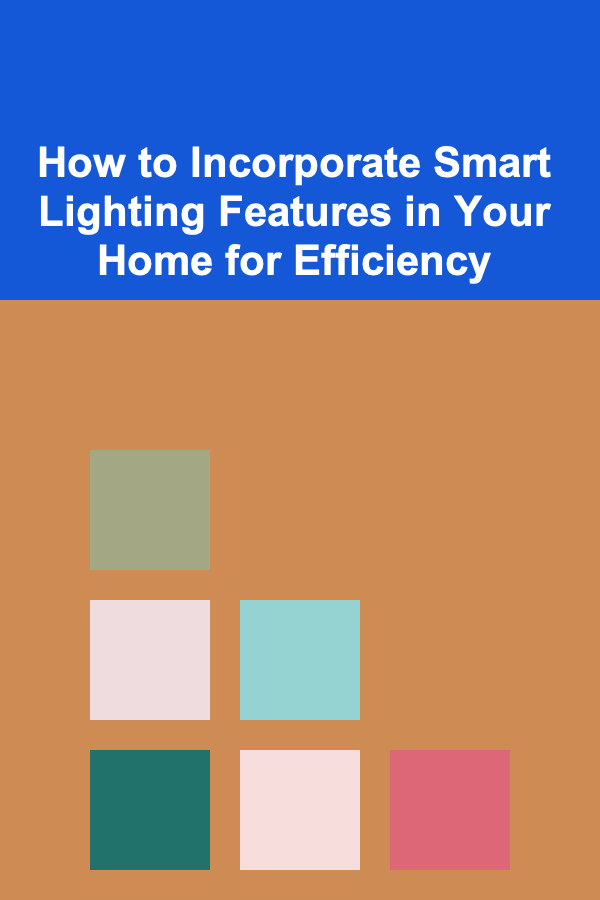
How to Incorporate Smart Lighting Features in Your Home for Efficiency
ebook include PDF & Audio bundle (Micro Guide)
$12.99$8.99
Limited Time Offer! Order within the next:

The rise of smart home technology has revolutionized the way we interact with our living spaces, and one of the most impactful advancements in this realm is smart lighting. Smart lighting allows homeowners to control the illumination in their homes with precision, customization, and efficiency. With the ability to automate lighting schedules, adjust the ambiance remotely, and integrate lighting systems with other smart devices, these systems offer more than just convenience---they help create an energy-efficient environment that can reduce utility costs and enhance the overall living experience.
Incorporating smart lighting into your home can be a transformative decision that enhances both the functionality and aesthetics of your living space. In this article, we will explore how to incorporate smart lighting features in your home to improve efficiency, from understanding the technology behind smart lighting to practical installation tips and ways to maximize its benefits.
Understanding Smart Lighting Technology
Before diving into how to use smart lighting in your home, it's important to understand the technology that powers it. Smart lighting typically consists of two primary components: smart bulbs and smart switches. These components can be controlled remotely through mobile apps, voice assistants, or even through automation.
Smart Bulbs
Smart bulbs are the foundation of smart lighting systems. These bulbs function like traditional bulbs, but with a key difference: they are equipped with built-in wireless connectivity, which allows them to communicate with your home network. Smart bulbs often use technologies like Wi-Fi , Bluetooth , or Zigbee to connect to your devices, allowing you to control them remotely.
Smart bulbs come with several features that can improve efficiency:
- Dimmable features: You can adjust the brightness of the bulb according to the time of day, mood, or need, which reduces energy consumption.
- Color-changing capabilities: Many smart bulbs allow you to change the color of the light, which can affect the ambiance of a room and even improve your well-being by mimicking natural light patterns.
- Energy-efficient technology: Smart bulbs typically use LED technology, which is much more energy-efficient than traditional incandescent bulbs.
Smart Switches
While smart bulbs are an excellent option for many households, smart switches offer a different approach. These devices replace your existing light switches and allow you to control the lighting from your phone, tablet, or voice assistant. With a smart switch, you can control multiple bulbs connected to the same circuit, which can be ideal for large spaces or multi-bulb fixtures. Smart switches work well in homes where you don't want to replace all of the bulbs with smart versions but still want to control them intelligently.
Key Features of Smart Lighting Systems
Smart lighting systems come with a variety of features that enhance their functionality and efficiency:
- Remote control: Smart lighting allows you to control your lights from anywhere using a smartphone app. Whether you're at home, at work, or on vacation, you can turn your lights on or off, dim them, or change their color with just a tap.
- Voice control: Integration with voice assistants like Amazon Alexa, Google Assistant, or Apple HomeKit means you can control your lights using voice commands. This is especially convenient when your hands are full or when you want to create a particular atmosphere in a room without having to get up.
- Automation: One of the most significant benefits of smart lighting is automation. You can set your lights to turn on or off at specific times, which is ideal for routines like waking up in the morning, coming home after work, or going to bed. This can help you save energy by ensuring that lights are only on when you need them.
- Geofencing: Some smart lighting systems have geofencing capabilities, meaning they can automatically turn on or off when you enter or leave a defined area, such as your home or driveway. This can be an excellent security feature or a way to avoid wasting energy.
- Energy monitoring: Some smart bulbs and switches offer energy monitoring features that track how much energy your lights are using. This can help you identify areas where you can cut back on usage and save on electricity costs.
How Smart Lighting Contributes to Energy Efficiency
Smart lighting is not just about convenience and comfort; it's also about reducing your energy consumption and creating a more sustainable home. By incorporating smart lighting features, you can lower your electricity usage and reduce your environmental impact. Here are several ways that smart lighting systems contribute to energy efficiency:
1. Reduced Energy Consumption with Dimming
Traditional incandescent bulbs consume energy at a fixed rate regardless of how bright the light is. However, smart bulbs, especially LEDs, can be dimmed to lower brightness levels, reducing the amount of power they use. This ability to adjust brightness based on need---whether you need a bright light to read or a dimmer light for a cozy atmosphere---means that you're not using excess energy when you don't need it.
2. Time-Based Automation
With time-based automation, you can schedule your lights to turn off when they're not needed. For example, you can program your lights to automatically switch off during the night or while you're at work. This prevents lights from being left on unnecessarily and ensures they're only on when needed.
3. Sensor-Based Lighting
Another great energy-saving feature of smart lighting is motion sensors. Some smart lighting systems include motion detectors that automatically turn the lights on when they detect movement and turn them off when there is no activity for a set period. This is particularly useful in areas like hallways, bathrooms, and garages where lights tend to be left on unnecessarily.
4. Geofencing for Automatic Control
Geofencing allows your lights to be automatically controlled based on your location. For instance, you can set your lights to turn off when you leave the house and turn them back on when you approach the front door. This ensures that lights are not left on when you're not at home, saving energy and reducing your utility bills.
5. Better Use of Natural Light
Smart lighting systems can be integrated with light sensors that monitor the natural light levels in a room. These systems can adjust the artificial lighting based on the amount of sunlight entering the room, ensuring that lights are only on when necessary. This is especially helpful in spaces with large windows where daylight can significantly influence the lighting requirements.
Steps to Incorporate Smart Lighting in Your Home
Now that you understand how smart lighting works and its energy efficiency benefits, it's time to explore how to integrate it into your home. Here's a step-by-step guide to incorporating smart lighting in your space.
Step 1: Determine Your Needs and Priorities
The first step in adopting smart lighting is to evaluate your needs. Do you want to create ambiance in your living room or simply want more efficient lighting in your kitchen? Consider the following questions:
- Which areas of your home do you want to automate (e.g., living room, hallway, bathroom)?
- Do you need dimming or color-changing capabilities?
- Are you interested in energy monitoring or simply in reducing electricity usage?
By considering your goals, you can determine whether smart bulbs, smart switches, or a combination of both is the best option.
Step 2: Choose a Smart Lighting Platform
There are several smart lighting platforms available, each with its own set of compatible devices and ecosystem. Some popular platforms include:
- Amazon Alexa: Works with a wide range of smart bulbs and switches, offering control via voice commands and the Alexa app.
- Google Assistant: Compatible with Google Home devices and a range of smart lighting brands.
- Apple HomeKit: A great option for Apple device users, with seamless integration across iPhones, iPads, and Apple Watches.
Ensure that the smart lighting products you choose are compatible with your preferred platform.
Step 3: Select the Right Smart Lighting Products
Choose the smart lighting products that best suit your needs and style. This could include:
- Smart bulbs: Consider purchasing smart bulbs for areas where you want the flexibility to adjust brightness or color. Popular options include brands like Philips Hue, LIFX, and TP-Link Kasa.
- Smart switches: If you want to control an entire circuit of lights, consider replacing standard light switches with smart versions.
- Motion sensors: If you want automation based on movement, smart motion sensors can be installed in areas where you frequently need lights.
Step 4: Install the Devices
Installing smart lighting is generally straightforward. Smart bulbs typically just screw into existing light fixtures, and many of them connect to your home's Wi-Fi network automatically. For smart switches, you may need to replace the existing switch, which could require basic electrical knowledge. If you're unsure, it's best to hire an electrician to ensure a safe installation.
Step 5: Set Up Automation and Control
Once your devices are installed, it's time to set up your automation and control preferences. Use your smart lighting app to:
- Set schedules for when lights should turn on or off.
- Customize scenes (for example, "movie night" with dimmed lights or "morning routine" with bright, energizing light).
- Link the system to your voice assistant for hands-free control.
Step 6: Monitor and Optimize for Efficiency
After setting up your smart lighting, monitor how much energy you're using and adjust settings to optimize efficiency. Many apps offer energy usage statistics, which can help you track savings and adjust automation to reduce waste further.
Conclusion
Incorporating smart lighting features into your home can significantly improve energy efficiency, reduce your electricity bills, and create a more comfortable, convenient living environment. By understanding the technology, choosing the right devices, and leveraging the automation and control capabilities of smart lighting, you can transform your home into an intelligent, energy-efficient space. Whether you're looking to enhance the ambiance of your home or simply make your daily routines more convenient, smart lighting is a powerful tool that offers a wealth of benefits for homeowners.
Reading More From Our Other Websites
- [Personal Care Tips 101] How to Make Your Nail Polish Remover Last Longer
- [Organization Tip 101] How to Organize Your Bathroom Cabinet for Beauty Routines
- [Home Storage Solution 101] How to Organize Kids' Toys Effectively and Maximize Storage Space
- [Home Space Saving 101] How to Save Space in Your Entryway with Multi-Use Furniture
- [Organization Tip 101] How to Choose the Right Storage Bins for Your Garage
- [Home Security 101] How to Prevent Break-ins with Simple Home Security Upgrades
- [Organization Tip 101] How to Create a Family Fitness Zone for All Ages
- [Personal Care Tips 101] How to Apply Hand Cream After Sun Exposure for Recovery
- [Home Space Saving 101] How to Turn a Cluttered Hallway into a Functional Zone Using Storage Ottomans
- [Home Renovating 101] How to Undertake DIY Home Renovation Projects for Beginners

How to Budget for a Family: A Comprehensive Guide
Read More
How to Make the Most of Your Closet Doors for Storage
Read More
How to Plan for Retirement at Any Age
Read More
How to Spot and Avoid Common Investment Scams
Read More
How to Plan for Retirement While Paying Off Student Loans
Read More
How to Handle Resistance to Agile Adoption
Read MoreOther Products

How to Budget for a Family: A Comprehensive Guide
Read More
How to Make the Most of Your Closet Doors for Storage
Read More
How to Plan for Retirement at Any Age
Read More
How to Spot and Avoid Common Investment Scams
Read More
How to Plan for Retirement While Paying Off Student Loans
Read More